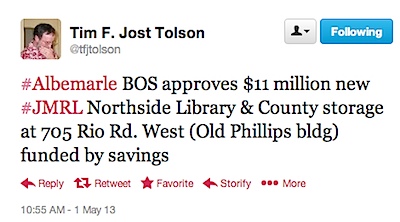I attended last night’s Crozet Community Advisory Council meeting, tweeted as much as I could and just put together a Storify of the meeting. Albemarle has a few of these Advisory Councils:
Crozet Community Advisory Council, Pantops Community Advisory Council, Places 29 (29 North), Village of Rivanna (east of Pantops) – and there are vacancies on the Pantops, Places 29 and Village of Rivanna Councils.
Here’s the thing – I learned a ton by being at and live-tweeting the meeting, and I noticed that I was getting interaction and questions from other people on Twitter who were unable to attend the meeting. I’ve made no secret of my affinity for Charlottesville Tomorrow; they are invaluable and their recent partnerships with the HooK and C-Ville will prove moreso.
But … having someone in the meeting engaging the community following was super-valuable. I’ve noticed this in Crozet several times as a watcher – one following the meeting from the outside. I’m interested in what’s happening at the meeting, but can’t attend (kids, work, family, etc) and a live-stream wouldn’t be as useful as tweets.
Take a look at the storify from last night’s Crozet meeting – there were a couple things in there that likely wouldn’t have made any story published elsewhere – they’re asides, but valuable asides, and mentions that don’t warrant individual stories. They’re valuable tweet-worthy asides.
What’s the point? The point is this –
If you can, find your way to community meetings – particularly ones that aren’t covered by media – and get involved, tweet the meetings and tell others. A lot of stuff happens and gets discussed in these meetings, and most often, the wider public learns about them after decisions are made.

